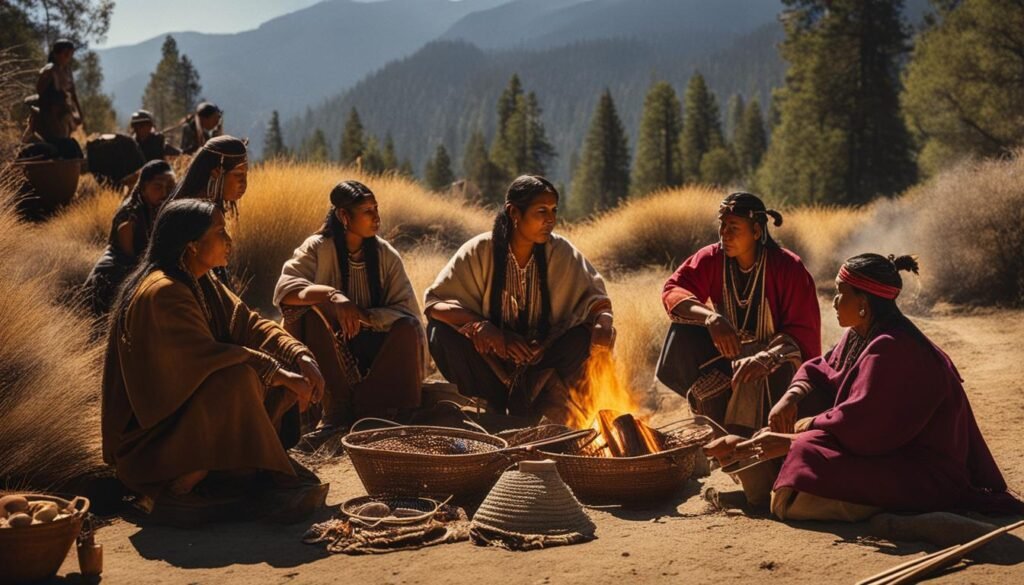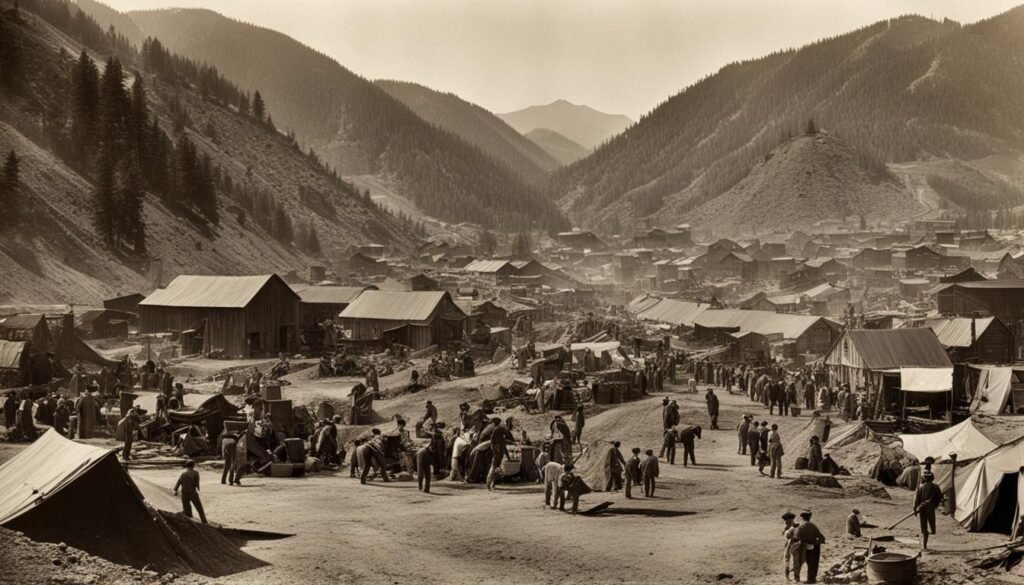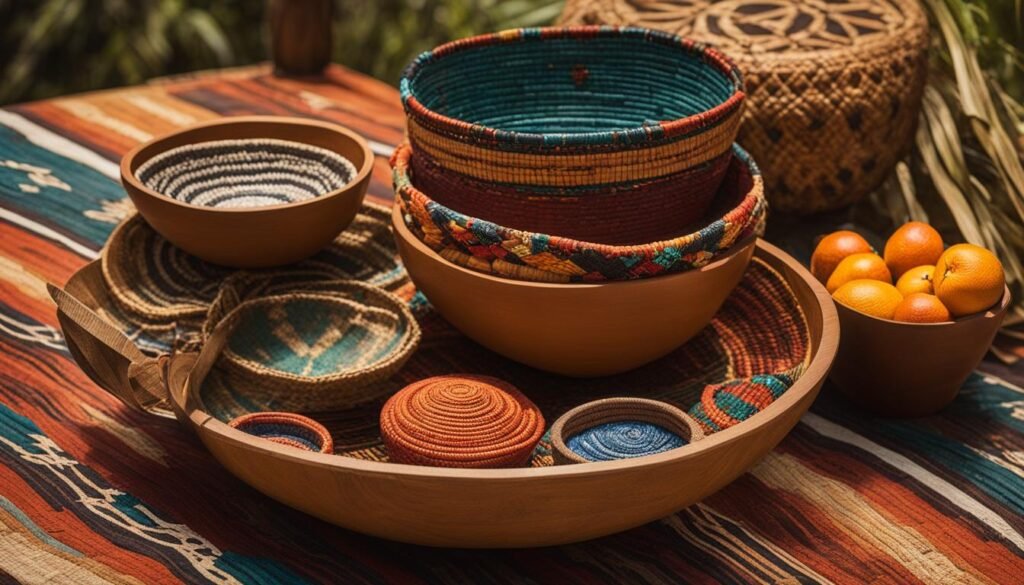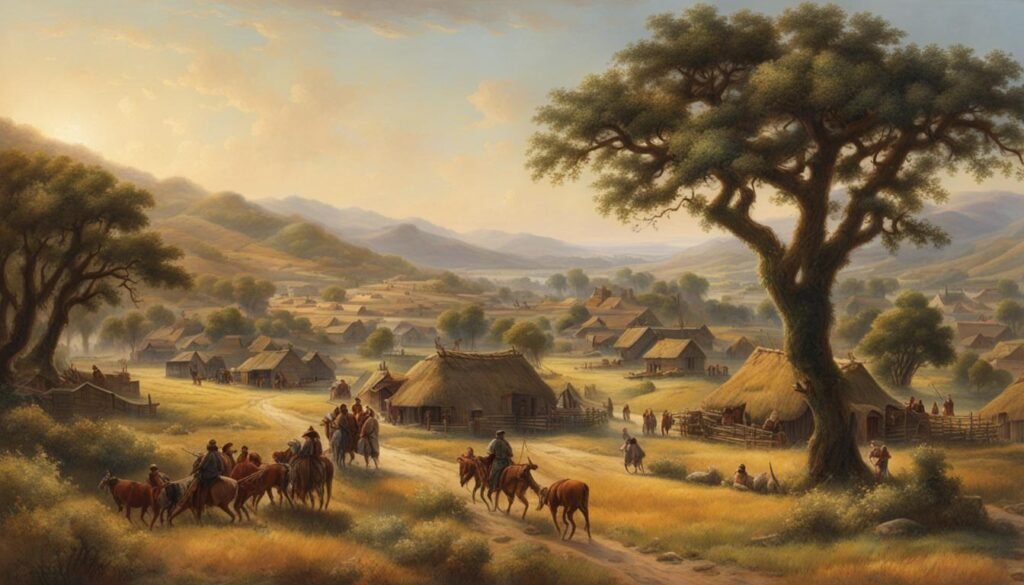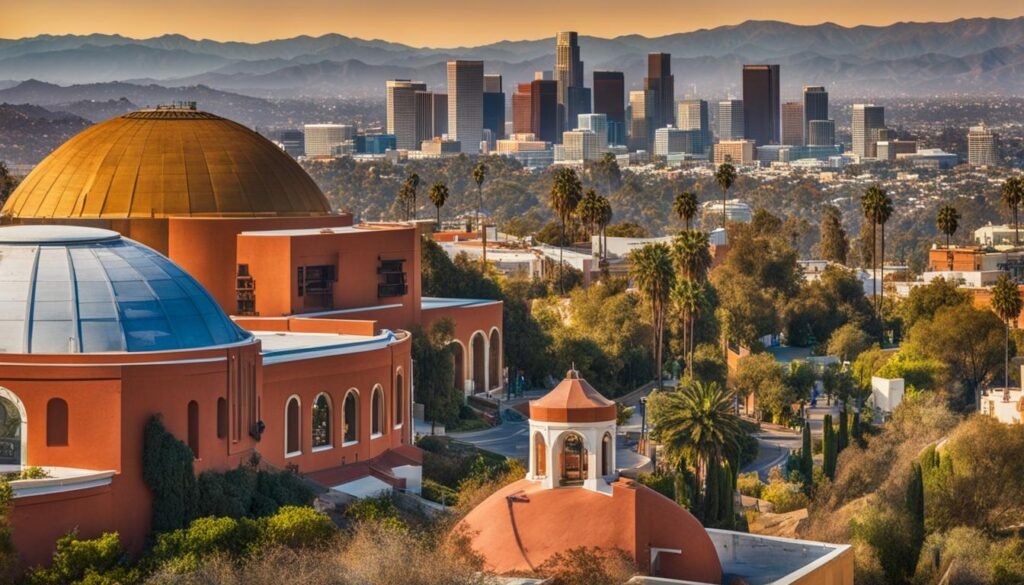Welcome to a journey through the rich culture and captivating history of Native Californians. As the indigenous people of California, they have shaped the diverse landscapes of this region and have a heritage that spans thousands of years. From the majestic redwood forests of the Northwest to the arid desert plains of the South, each tribe has its own unique customs, traditions, and way of life.
As we delve into the world of Native Californians, we will explore their regional lifeways, material aspects, rituals and traditions, and the impact of Spanish colonization. We will also discover the diversity and isolation of these tribes, and how they continue to thrive in modern society. Let’s embark on this enlightening journey and gain a deeper understanding of the rich cultural heritage of California’s indigenous people.
Key Takeaways:
- The Native Californian tribes have a diverse and fascinating culture shaped by the diverse landscapes of California.
- There are distinct regional lifeways among the tribes, with each region having its own unique characteristics and customs.
- Basketry is an essential craft across all Native Californian tribes.
- Native Californian tribes have rich ritual and ceremonial traditions that are deeply intertwined with their cultural identity.
- The arrival of the Spanish in the 18th century had a profound impact on Native Californians, leading to cultural suppression and displacement.
Regional Lifeways of Native Californians
Native Californian tribes can be categorized based on their regional similarities. Each region had its unique geographical features, which influenced the lifeways and cultural practices of the indigenous tribes.
1. Northwestern Tribes
The Northwestern tribes, such as the Tolowa and Yurok, lived in the lush rainforest environment. They relied on the abundant rivers and coastal bays for transportation and resources. Fishing played a vital role in their sustenance, with salmon being a significant food source. These tribes crafted canoes from the massive redwood trees found in the region, utilizing them for fishing and transportation.
2. Northeastern Tribes
The Northeastern tribes, like the Modoc and Atsugewi, inhabited the wooded mountains and valleys of California. Acorns, salmon, and grass seeds formed the staple diet of these tribes. They practiced hunting and gathering, supplementing their food with the resources available in the region. The forests provided shelter materials and medicinal plants, which were essential elements of their way of life.
3. Central California Tribes
The Central California tribes, including the Pomo and Miwok, resided in the central valleys of the state. This region was characterized by fertile soil and a diverse range of wildlife. As agriculturalists, these tribes cultivated crops like acorns, grasses, and berries. They relied on hunting, fishing, and gathering to supplement their diet. The abundance of natural resources contributed to their settled lifestyle and flourishing communities.
4. Southern Tribes
The Southern tribes, such as the Chumash and Cahuilla, inhabited the coastal regions and deserts of California. They had access to rich marine resources and a variety of desert plants and animals. The Chumash, in particular, were skilled seafarers, relying on fishing, shellfish gathering, and trading with neighboring tribes. The deserts provided a unique range of edible plants and small game for the survival of the tribes in this region.
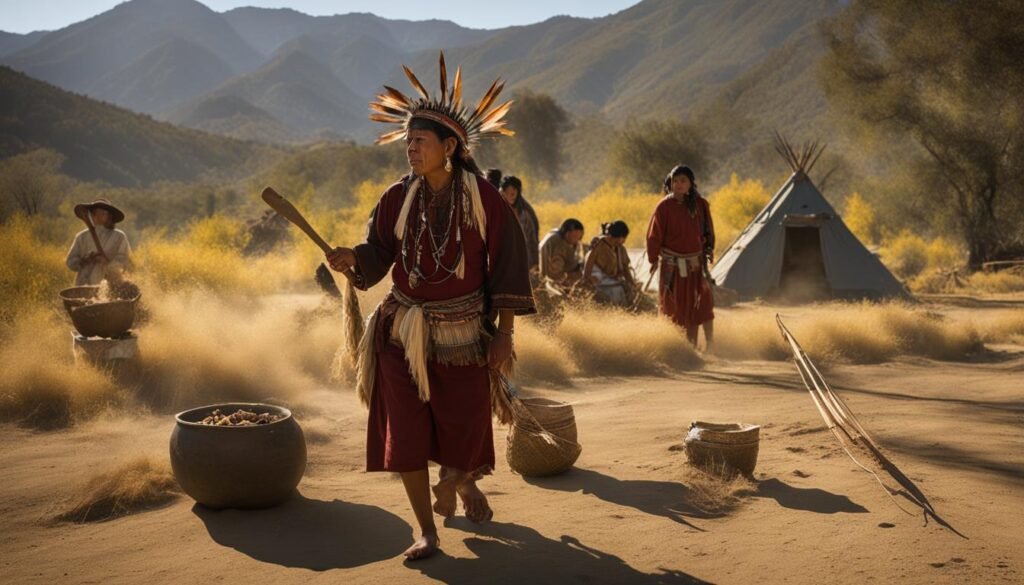
The lifeways of Native Californians were closely intertwined with the natural resources and landscapes of their respective regions. These regional differences gave rise to diverse cultural practices and traditions among the indigenous tribes of California.
Material Aspects of Native Californian Tribes
Native Californian tribes have a rich cultural heritage that encompasses not only their traditions and rituals but also their material aspects. These tribes used similar technologies and materials to construct their tools, homes, and storage containers, showcasing their innovative spirit and resourcefulness.
The Northwestern tribes, such as the Tolowa and Yurok, harnessed the impressive giant redwood trees that dominated their environment. These towering trees provided the raw materials for crafting sturdy canoes and building durable houses, allowing them to navigate the coastal waters and create secure dwellings.
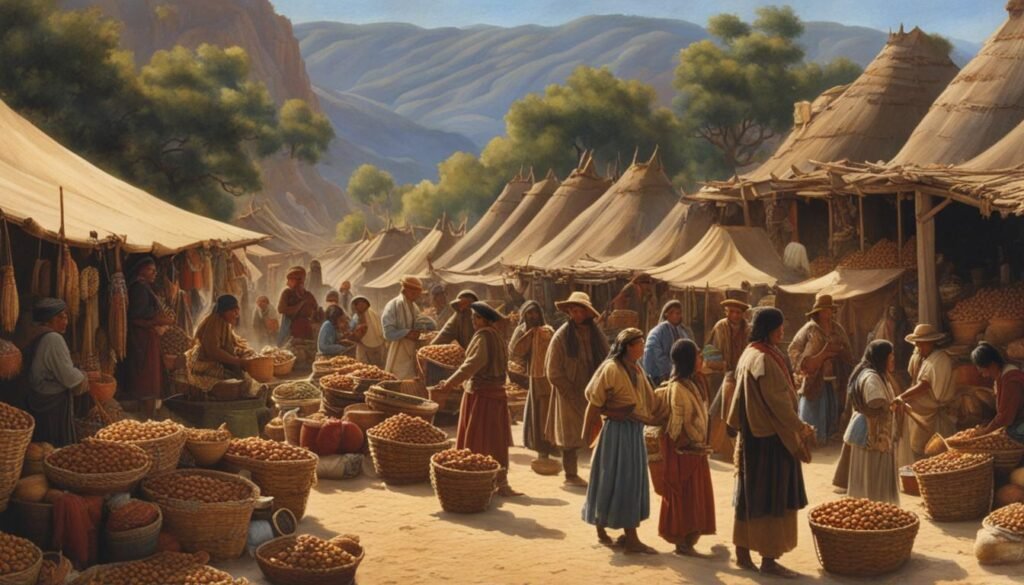
Basketry was a significant craft across all regions, showcasing both the practical and artistic skills of Native Californians. In Central California particularly, basketry flourished, reaching unparalleled heights of variety and intricacy. The Pomo tribe, known for their elaborate designs, created baskets that served both utilitarian and ceremonial purposes.
These material aspects of Native Californian culture continue to be celebrated and practiced today, with many tribes actively passing down their knowledge and skills to future generations. The art of basketry, for instance, remains a cherished tradition that showcases the ingenuity and cultural heritage of indigenous communities in California.
Rituals and Traditions of Native Californians
The Native Californians had a rich ritual and ceremonial life. Their traditions and rituals were deeply intertwined with their cultural identity and continue to be practiced by some Native Californians today. Let’s explore some of the fascinating rituals and traditions of the indigenous peoples of California.
World Renewal Ceremony
One notable ritual practiced by Northwestern tribes was the World Renewal ceremony. Held each Fall, this ceremony aimed to prevent natural disasters and ensure the well-being of their communities. Through elaborate rituals, songs, and dances, the tribes sought to renew the balance and harmony of the world around them.
Kuksu Dances
In Central California, the Kuksu dances were an important tradition for renewing the world’s natural food resources. These dances were performed by the tribes to connect with the spiritual world, seek blessings for bountiful harvests, and maintain a harmonious relationship with nature.
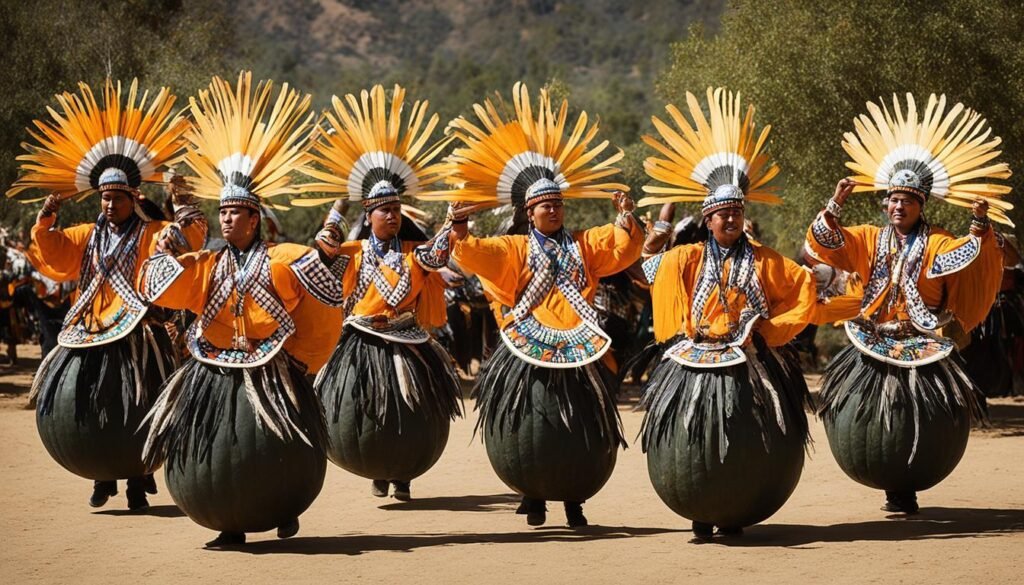
Cultural Significance
These rituals and traditions of Native Californians held great cultural significance. They were not only a means of spiritual connection but also a way to pass down knowledge, preserve cultural identity, and reinforce social bonds within the community. Despite the challenges faced by Native Californians throughout history, many continue to honor and practice their ancestral rituals today, keeping their cultural heritage alive.
Impact of Spanish Colonization on Native Californians
The arrival of the Spanish in the 18th century marked a pivotal moment in the history of Native Californians. The establishment of missions by the Franciscan padres had far-reaching consequences for the indigenous population. The primary goals of the missions were to convert the Native Californians to Christianity and assert Spanish control over the region.
However, the impact of Spanish colonization on the native tribes of California was devastating. Many tribes were forcibly displaced from their ancestral lands, leading to the loss of their cultural identity and traditional way of life. The missions relied heavily on the labor of Native Americans, who were often subjected to harsh conditions and treated as indentured servants.
Furthermore, the Spanish colonization brought with it European diseases, such as smallpox and measles, to which the Native Californians had little immunity. These diseases decimated the indigenous populations, leading to further loss of life and cultural practices.
The Spanish also introduced new agricultural practices and introduced foreign animals, which significantly altered the ecological balance of the region. Native Californians had to adapt to these changes, further disrupting their traditional way of life and connection to the land.
The impact of Spanish colonization on Native Californians cannot be understated. Considered a dark period in the history of California, it resulted in the loss of autonomy, cultural suppression, and the displacement of numerous tribes. Despite these challenges, the Native Californians have demonstrated remarkable resilience in preserving their cultural heritage and reclaiming their place in modern society.
Diversity and Isolation of Native Californian Tribes
The Native Californian tribes were incredibly diverse, with over 135 distinct dialects and a wide range of customs. This rich cultural tapestry was shaped by the rugged topography and geographical barriers of California, which contributed to the isolation of these tribes. As a result, each group developed its unique traditions and practices, ensuring a vibrant native Californian culture.
Unlike larger tribes found in other parts of the country, the California tribes lived in smaller family groups or clans and had a less complex political structure. This close-knit community structure fostered a strong sense of unity and collaboration within the tribes. Despite their differences, the tribes generally enjoyed a peaceful coexistence due to the challenging terrain of the mountainous regions, which made extensive warfare impractical.

The isolation of these tribes allowed for the development of distinct local customs and practices. From the rich coastal traditions of the Chumash tribe to the resourceful survival techniques of the Pomo tribe in central valleys, each tribe showcased its unique way of life. This diversity of cultures and practices contributed to the rich tapestry of native Californian heritage.
Modern Native Californian Communities
Today, Native Californians continue to maintain and celebrate their cultural heritage. California is home to over 100 federally recognized tribes, comprising a population of approximately 1.4 million Native Americans and Alaskan Natives. These vibrant communities have established cultural centers and museums to preserve and promote their traditions.
These cultural centers offer visitors a unique opportunity to learn about the rich history of Native Californians and engage with the modern lives of indigenous communities. Through exhibits, artifacts, and interactive experiences, visitors can gain a deeper understanding of the diverse customs, art forms, and spiritual practices that have shaped the indigenous cultures of California.
Native Californian tribes actively participate in cultural exchanges, powwows, and other events where they showcase their traditions, dances, music, and storytelling. These events invite people from all backgrounds to immerse themselves in the vibrant heritage of the tribal communities in California.
As a visitor, you can explore the impressive craftsmanship of Native Californians by viewing their intricate beadwork, basketry, and traditional clothing. Many cultural centers also offer workshops and demonstrations, allowing you to learn directly from Native Californian artisans and gain firsthand experience with their traditional practices.

By visiting these cultural centers and engaging with the modern lives of indigenous Californians, you can develop a deeper appreciation for their rich heritage and contribute to the preservation and celebration of their cultural traditions.
Experiencing Native Californian Culture
When visiting California, exploring the rich cultural heritage of Native Californians is a must. Immersing yourself in tribal museums and cultural centers allows you to delve into the fascinating history and traditions of indigenous tribes. These institutions house a treasure trove of artifacts, art, and knowledge from various tribes, offering a glimpse into the vibrant tapestry of Native Californian culture.
To enhance your cultural experience, consider visiting the Agua Caliente Band of Cahuilla Indians’ upcoming cultural plaza in Palm Springs. This extraordinary site will feature an impressive museum that showcases the rich history and traditions of the tribe. The museum will provide invaluable insights into the cultural heritage of the Cahuilla people and their significant contributions to California’s indigenous heritage.
Another remarkable cultural center is the Barona Cultural Center & Museum in San Diego County. This institution provides a unique opportunity to learn about the Kumeyaay/Diegueño people, their rich historical legacy, and their enduring traditions. Through interactive exhibits and engaging displays, visitors gain a deeper understanding of the tribe’s way of life and their vital connection to the land.
Attending Pow Wows is another excellent way to experience the vibrant indigenous traditions of California. Pow Wows are intertribal gatherings that bring together Native American communities from various tribal backgrounds. These events feature traditional dances, music, and storytelling, offering a mesmerizing display of Native Californian cultural heritage. Pow Wows provide a perfect opportunity to engage with the tribes and witness their deeply rooted traditions in action.
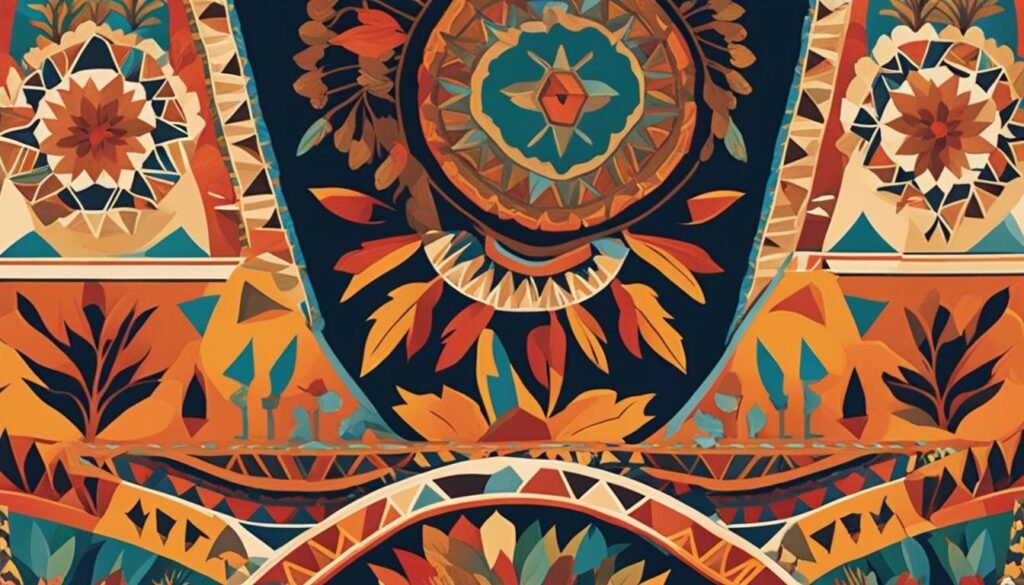
By immersing yourself in the Native Californian culture through museum visits and attending Pow Wows, you can gain a profound appreciation for the rich cultural heritage of California. These experiences not only educate and inspire, but they also foster a sense of connection and respect for the indigenous traditions that have shaped the state’s history.
Exploring Native Californian Lands
Native Californian lands provide a gateway to unforgettable outdoor adventures and the chance to immerse oneself in the beauty of indigenous culture. Whether it’s experiencing ancient traditions, paddling in authentic dugout canoes, or exploring natural desert oases, there are countless opportunities to connect with the land and discover the rich heritage of the tribes of California.
Yurok Tribe Guided Tours
For a truly immersive experience, the Yurok Tribe in Klamath offers guided tours of the majestic Klamath River. Led by tribal members, these tours provide insights into the tribe’s traditions, allowing visitors to paddle in authentic dugout canoes and gain a deeper understanding of the indigenous way of life.
Coachella Valley Exploration
In the heart of the Coachella Valley lies Agua Caliente tribal land, where visitors have the opportunity to explore natural desert oases and sacred canyons. Here, you can venture into the stunning landscapes that have shaped the indigenous culture of the region, gaining a newfound appreciation for the land’s spiritual significance and natural beauty.
Hiking Adventures at Los Coyotes Reservation
If you’re seeking an adventurous hiking experience, look no further than the Los Coyotes Reservation, located on the border of Anza-Borrego Desert State Park. The reservation offers hiking permits, allowing you to explore the breathtaking desert landscapes and immerse yourself in the diverse flora and fauna surrounding you.
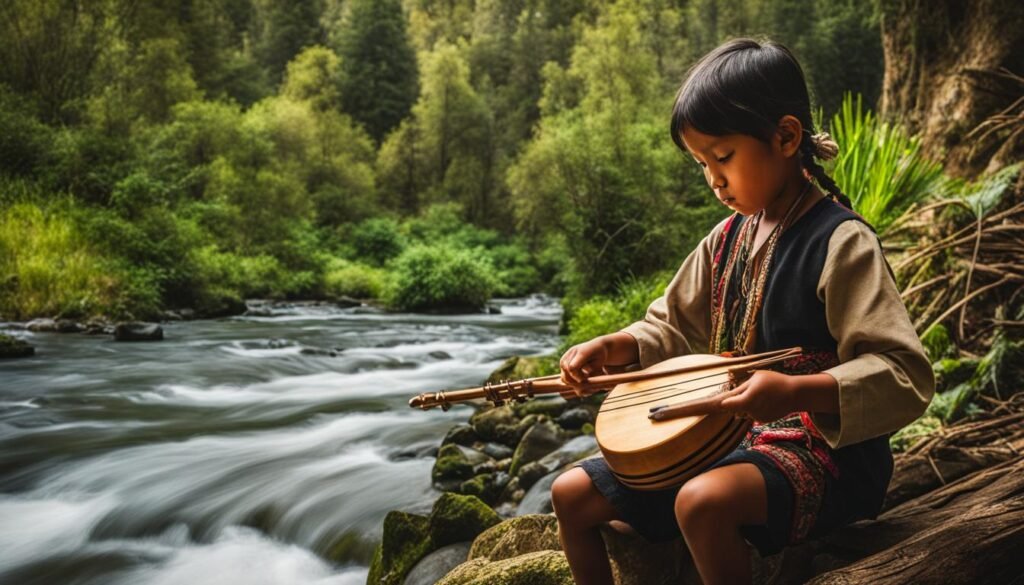
As you explore these Native Californian lands, you’ll discover the intricate connection between the indigenous people and their surroundings. Whether you choose to embark on a guided tour, explore sacred sites, or hike through beautiful landscapes, each experience enables you to appreciate the rich cultural heritage of the tribes of California.
Museums and Cultural Centers on Tribal Lands
Several Native American tribes operate museums and cultural centers on their historic lands, which are now managed as part of national parks and forests. These centers offer a unique perspective on the tribes’ history and culture within their ancestral territories.
The Haramokngna American Indian Cultural Center in the San Gabriel Mountains tells the story of five regional tribes. Visitors can explore exhibits showcasing traditional arts, crafts, and artifacts, providing insights into the rich native American heritage of the area.
Another cultural center worth visiting is the Satwiwa Native American Cultural Center located in the Santa Monica Mountains. This center focuses on preserving and celebrating the Chumash and Tongva cultures, offering educational programs, events, and exhibits that showcase their traditions and history.
Those interested in experiencing the native American heritage while visiting Sequoia National Forest can explore the Nuui Cunni Cultural Center. This cultural center, situated on reservation land, provides visitors with the opportunity to learn about the indigenous tribes’ unique traditions, customs, and way of life.
These museums and cultural centers on tribal lands offer invaluable insights into the native American heritage and the tribes’ enduring legacy in California. Exploring these sites provides visitors with a deeper appreciation for the rich history and culture of the tribes in California.
Recognition and Preservation of Native Californian Culture
Efforts are underway to recognize and preserve the rich cultural heritage of the native tribes of California. Land restorations and repatriation of artifacts play a vital role in acknowledging and respecting the indigenous peoples of California. These significant steps aim to restore the land to its original owners and return sacred objects to their rightful communities.
Various tribes, museums, and educational institutions are leading initiatives to promote awareness and understanding of Native Californian traditions. Through exhibitions, educational programs, and cultural events, they strive to ensure that the history, customs, and beliefs of the native tribes of California are safeguarded for future generations.
By preserving and honoring these traditions, we can foster appreciation for the diverse cultural heritage of California and create a more inclusive society. Let’s join hands in preserving the remarkable legacy left by the native tribes of California.
Conclusion
Native Californians possess a rich and diverse cultural heritage that has resiliently endured the challenges of centuries. Today, they continue to thrive and contribute to the vibrant tapestry of California’s cultural landscape. It is crucial for us to acknowledge and honor the indigenous peoples of California, to learn from their past, customs, and traditions, and to actively support their endeavors in preserving and celebrating their unique heritage.
By embracing and appreciating the Native Californian culture, we not only gain a deeper understanding of the state’s history but also foster a more inclusive and diverse society. Recognizing the contributions and resilience of the California native population is essential in shaping a society that values and respects the diverse cultural backgrounds that enrich our communities.
Let us work together to ensure the preservation and continuation of Native Californian traditions. By respecting their ancestral lands, supporting their educational initiatives, and actively engaging with their art, history, and customs, we can play a vital role in safeguarding the cultural legacy of the indigenous peoples of California for generations to come.
FAQ
Who were the Native Californians?
The Native Californians were the indigenous peoples of California, with diverse cultural heritage and traditions shaped by the varied landscapes of the region.
How were the Native Californian tribes categorized?
The Native Californian tribes were categorized based on their regional similarities, such as the Northwestern, Northeastern, Central, and Southern tribes.
What were the material aspects of Native Californian culture?
Native Californians used materials like redwood trees for canoes and houses, and basketry was an important craft across all regions.
What were some of the rituals and traditions of Native Californians?
Native Californians had rituals like the World Renewal ceremony in the Northwestern tribes and the Kuksu dances in Central California.
How did Spanish colonization impact Native Californians?
Spanish colonization led to the displacement, cultural suppression, and loss of autonomy for many Native Californian tribes.
How were Native Californian tribes diverse?
Native Californian tribes were diverse in terms of dialects, customs, and political structures, with smaller family groups or clans and peaceful coexistence.
How do Native Californians maintain their cultural heritage today?
Native Californians maintain and celebrate their cultural heritage through cultural centers, museums, and the preservation of their traditions.
How can visitors immerse themselves in Native Californian culture?
Visitors can immerse themselves in Native Californian culture by visiting tribal museums, attending Pow Wows, and exploring tribal lands and natural sites.
Are there museums and cultural centers on Native Californian tribal lands?
Yes, there are museums and cultural centers on Native Californian tribal lands, offering insight into the history and culture of various tribes.
What efforts are being made to recognize and preserve Native Californian culture?
Efforts such as land restorations, repatriation of artifacts, and initiatives by tribes, museums, and educational institutions aim to recognize and preserve Native Californian culture.

